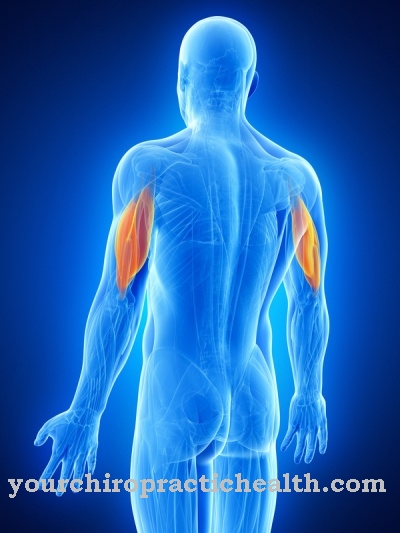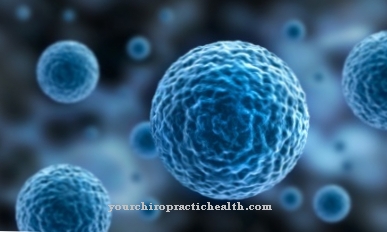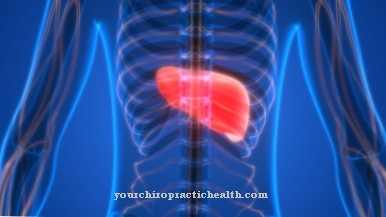The adhesion In medicine, describes the attachment force between two or more organic layers or structures. For example, it enables blood cells to adhere to the vessel wall and thus move independently of the blood flow. In the pathological sense, adhesion is an intergrowth of organ sections that can arise, for example, after an operation.
What is the adhesion?

In the case of adhesion (also in technical terms Adhaesio) it is about the adhesion of molecules to a phase interface. The phase boundary is created between two layers or objects, each of which is relatively homogeneous and thus delimits itself from their surroundings. For example, there is a phase interface between different tissue layers: each layer has a different molecular structure and thus forms its own unit. The phase interface is not a physical, additionally existing, tissue layer but refers to the interface between the molecules or tissues.
The attachment force comes about due to physical interactions. The molecules attract, repel and react with one another biochemically. In the case of adhesion, these effects cause the molecules to attract each other.
Function & task
Adhesion plays an important role in countless processes in the human body. For example, some blood cells adhere to the walls of blood vessels so as not to be caught in the bloodstream. Some blood cells are also able to move along the vessel walls in this way. This benefits, among other things, cells of the immune system, which can specifically seek out sources of infection.
Recent research shows that, for example, a certain type of T-cell not only moves on the inner wall of blood vessels, but can also move against the bloodstream. It is also documented that these T cells can even cross the blood-brain barrier. Despite some theories, the purpose of the migration has not yet been conclusively clarified; however, it appears to be related to neurological diseases.
In addition, platelet adhesion is essential for the blood to clot. The organism reacts to injuries and prevents excessive blood loss. When the blood clots, the thrombocytes or platelets form a relatively stable association by sticking to one another.
Other cells are also subject to adhesion. The tissue of a skin or an organ consists of numerous cells that form a homogeneous mass. Different tissues adhere to each other, for example to form the different structures in an organ. The serosa, a reddish skin, adheres to the organs thanks to its adhesion. During cell adhesion, the tissue cells hang on to proteins in the extracellular matrix. The extracellular matrix is tissue in the intracellular space. It consists primarily of connective tissue and is involved in the supply of cells, signal transmission and shaping.
The adherence of bacteria to mucous membranes is relevant for bacteriology. Many bacteria that spread through the air they breathe enter the human body through the mucous membranes. In the course of evolution, bacteria have therefore adapted to the molecular properties of the mucous membranes. This enables them to penetrate the organism and multiply in the body. Bacterial infections often - but not always - lead to disease.
You can find your medication here
➔ Drugs for wound treatment and injuriesIllnesses & ailments
In medicine, adhesion also has a pathological significance. Inflammation can change the adhesion of tissue layers. This leads to the formation of connective tissue adhesions. Fibrin sticks the tissue together. Fibrin is a protein that, when activated, acts like an adhesive and is normally involved in blood clotting, among other things. The adhesions that arise in this way can take on either planar or rod-shaped shapes. Pathological adhesion affects organ sections that lie against one another and are covered by the serosa. Adhesions and adhesions do not have to be immediately noticeable, but soon lead to functional restrictions of the affected organs.
One form of pathological adhesion is the abdominal bond or bride. "Bride" is derived from the French word "brider", which means something like "tie together". In the case of the abdomen, the adhesions are located in the abdominal cavity and form a scar. Because of the location of the adhesions, medicine also calls the condition intra-abdominal adhesion. For example, it can occur after operations; however, slightly more than 10% of the clamps form for other reasons. An abdominal adhesions need not pose an immediate danger to the organism and can also be completely harmless in the long term if the pathological adhesion is primarily limited to supporting tissue.
One possible complication that can develop as a result of adhesions in the abdominal cavity is the adhesion ileus or briden ileus. The medicine describes an ileus as an intestinal obstruction, which brings with it the risk of an intestinal tear. More rarely, an adhesion ileus leads to a restriction or interruption of the blood supply. If part of the tissue is no longer adequately supplied with blood, the cells may die (necrosis). The adhesion ileus is a mechanical ileus. In contrast to the functional ileus, a mechanical ileus can often be treated with an operation. A functional ileus, for example, can result from poisoning or paralysis of the intestinal muscles. The therapy depends on the specific cause.
Even rod-shaped adhesions in joint capsules and other parts of the body are sometimes referred to as bride. This type of adhesion may limit the functionality of the affected joint.













.jpg)

.jpg)
.jpg)











.jpg)